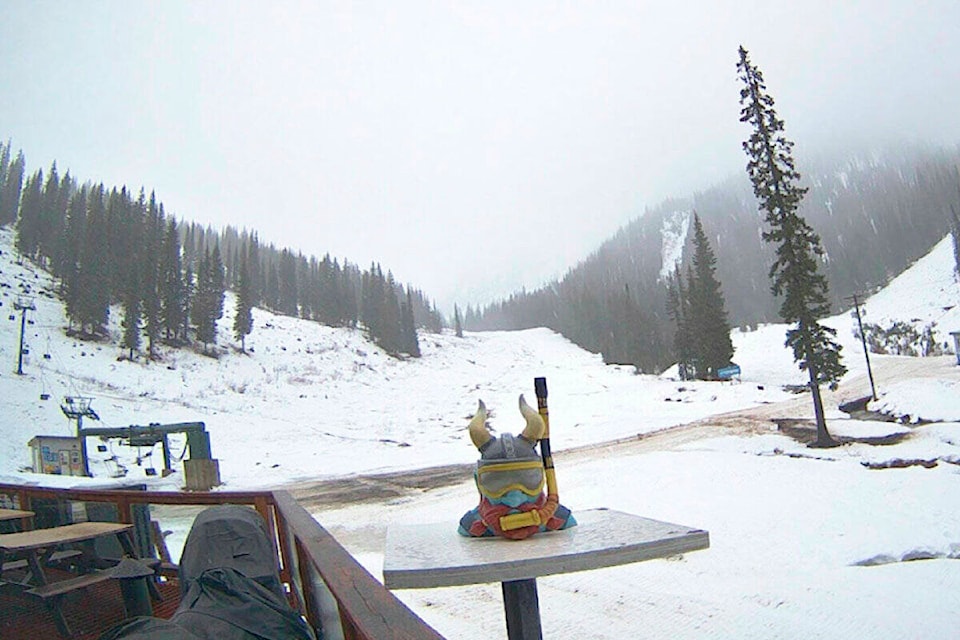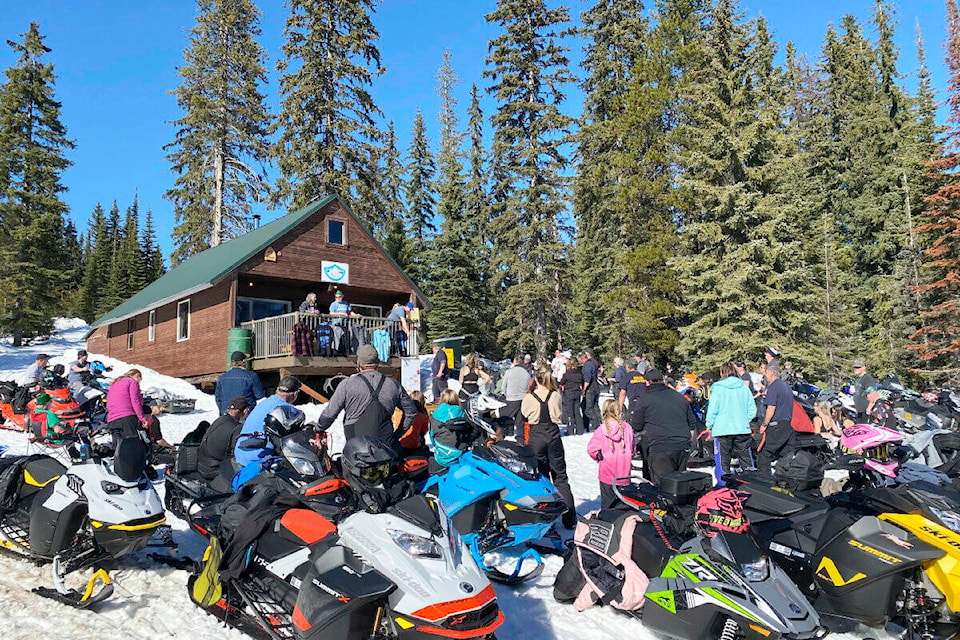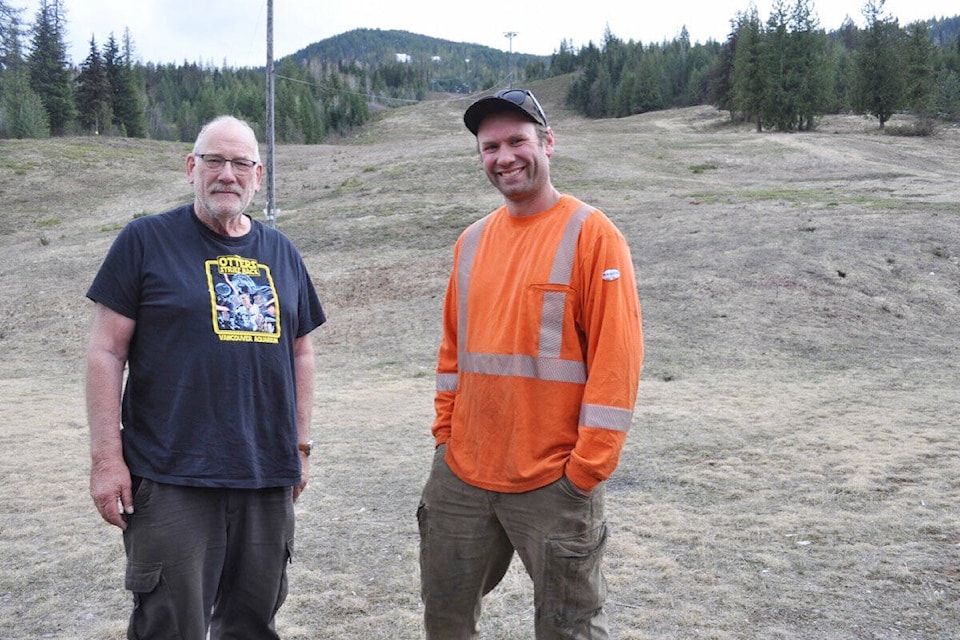In part two of this four-story series, we look at what the reduced snowpack means for the West Kootenay’s winter recreation. Read part one about the drinking water supply .
Wally Huser walks over dusty earth where spring grass has yet to appear and gazes up the ski hill he’s spent his entire life on.
For more than 60 years, the Huser family has played and worked at the Salmo Ski Hill. Wally’s parents were among the community members who helped build the hill. After it opened in 1963, Wally’s father ran the lift and his mother worked at the concession.
Wally first learned to ski on the small hill when he was five years old. As a teenager he competed in ski racing. As an adult he joined the board of directors, served as a president, and continues to volunteer his own time to keep it going. A third generation of Husers has also since taken to the hill — Wally’s son Levi grew up on its slopes and later served as its president when he was still in his 20s.
But after a season during which the Salmo Ski Hill was opened just 14 days, Wally prefers to be grateful for the decades it has provided recreation to the community rather than ponder its uncertain future.
“I’m happy we’ve lived this long. That’s the way to look at it.”
At Salmo Ski Hill and elsewhere across the West Kootenay, a low snowpack has impacted the winter recreation industry. On Jan. 1, the region’s snowpack was just 57 per cent of normal. It gradually improved, but as of April 1 when most seasonal snow has usually fallen it was still just 72 per cent.
The lack of snow meant an often torturous season for the people who run ski hills big and small.
Summit Lake Ski and Snowboard Hill southeast of Nakusp has the region’s lowest ski hill elevation. Butch Warantz, a former president and current director on Summit Lake’s board, has been involved with the hill for 40 years.
Since the season ended, he’s been problem-solving how to keep selling season passes for a hill that was only open two weeks in January, then just two more days in March. Convincing pass holders to return at full price, Warantz says, might be too much of an ask.
”They understand that it’s nothing that the board or the ski hill could possibly do to change things. We’re just hoping that we can come up with something that we can give back to the membership for next year.”
Summit and Salmo are the region’s smallest hills by peak elevation, but are also valued community assets. Both offer cheap season passes and day tickets. Salmo’s only paid employees are teenage students who typically submit what is the first resumé they’ve written.
It’s a model that keeps skiing and snowboarding financially accessible to residents, who can learn how to navigate the slopes before visiting larger hills such as Nelson’s Whitewater Ski Resort.
“In Salmo, we never, ever thought of skiing as anything elite,” says Levi Huser. “Everyone just did it, because everyone could do it. I think if you zoom out it’s a much different culture around here than in other places. But to us it was just normal.”
To keep that culture from melting away, both hills are considering their options.
Warantz says Summit recently applied for a cutting permit that would allow access to snow at a higher elevation and in turn — depending on the temperatures — a longer season.
Salmo is trickier. The tenure rights to the area above the hill belong to a logging company, and the Husers say going up that high would require a new chair lift. But the hill doesn’t get enough visitors to justify the investment.
A more likely solution would see Salmo groom the hill during the off-season so it can operate with less snow. It also has commercial water rights to a nearby creek that could be accessed by a snowmaker to provide for the lower section of the hill.
Levi, however, is skeptical making snow would be worth the effort for an operation of Salmo’s size.
“It’s a pain in the ass, and it melts.”

The rollercoaster
As the new season approached, Whitewater Ski Resort put the finishing touches on its first new lift in six years.
The Raven quad chairlift was set to open up 160 new acres of terrain. But to do that it needed snow.
An atmospheric river dropped 90 millimetres of rain — and only five mm of snow —in the days leading up to Whitewater’s Dec. 8 opening, forcing the resort to push back its season by a week.
Concerns about the season were short-lived. The snow began falling within days.
Whitewater’s general manager Rebeckah Hornung describes the season as “an emotional rollercoaster.” She has no regrets though about adding another chair lift.
“I have a lot of faith in Whitewater and what it will provide in terms of snow. … I was really excited to be able to showcase that chair, and it really brought a lot of morale boost to the community.”
In Rossland, Red Mountain was forced to push its opening day back from Dec. 10 to Dec. 28, but all lifts were operating by early January and the resort otherwise carried on as normal.
Red’s GM Andrew Lunt, who has worked in the ski tourism industry for 23 years, says he’s come to anticipate how unpredictable conditions might be.
But Red is still being proactive. Lunt says the resort is investing in snowmaking as well as summer terrain management to keep runs clean. At some point, he says, Red might even add new lifts that can access areas with early season snow.
“I think resorts will do a lot to continue to develop that infrastructure and that ability to continue to open for what we would kind of assume and deem a regular season in North America.”
Christopher Nicholson is president of the Canada West Ski Areas Association, which represents 130 ski areas located in B.C., Alberta, Saskatchewan, Manitoba and Yukon. He said hills the size of Salmo’s represent the majority of ski areas in Western Canada, but not all of them are struggling in the same way, depending on location.
More resorts, however, are reconsidering how they can keep customers coming back even when there’s no snow. Year-round diversification, Nicholson said, can generate revenue and also guarantee jobs to more qualified employees.
“It allows for the professionalism of the industry. If you look at the last 30-40 years within the west, that’s absolutely what you’ve seen where you’ve got long-time careers, and they are tourism professionals or ski area professionals.”
That’s already the case at Whitewater, which last summer opened its Hummingbird Lodge for off-season stays and has in recent years expanded its trail network.
But winter is still the draw, and Hornung is confident Whitewater will operate even in years with diminished snow.
“We can only do as much as Mother Nature gives us, for sure. But I think knowing the importance of Whitewater in terms of an economic driver for the community, we will continue to adapt as we need to.”
Whack-a-mole
When snow is in short supply, size matters.
Baldface Valhalla near Nelson boasts the West Kootenay’s biggest outdoor recreation area. Its peak elevation is 2,438 metres, over 300 higher than Red, and it offers 32,000 acres of terrain.
Owner and founder Jeff Pensiero had climate change in mind when he opened Baldface Lodge 24 years ago. The company initially applied for a 64,000-acre tenure for their operation, based on the assumption that if it one area was low on snow there would still be plenty of powder elsewhere.
That planning panned out. In a typical year, Pensiero says Baldface will receive 10-30 centimetres of snow every two or three days through the end of February. This year it was about four-eight cm, which Penseiro said was just enough to operate with.
“When it doesn’t snow, we’ve got lots of places to go. Red and Whitewater are lift access, and they’re significantly smaller. So when it doesn’t snow for a long time, everything gets tracked out and frozen and the conditions aren’t very good. The fact that we can move around everywhere really helps us out a lot.”
Baldface has another advantage that keeps it viable.
Guests book a year ahead for their stays — Baldface Lodge is already sold out for the 2024-25 season — that in turn guarantees revenue and means its business isn’t as weather dependent.
As the snowpack melts, Pensiero believes that will make what snow does remain more valuable.
“If there’s only eight weeks of winter instead of 14 weeks of winter, those eight weeks will cost the same as my 14 weeks now. And people will pay it.”
Pensiero conceded he isn’t sure how future snowpacks will be at Baldface. Changing conditions make for unpredictable business, but sometimes it works out in a resort’s favour.
To make his point, Pensiero points to Mammoth Mountain, California’s highest elevation ski resort. In January, California’s snowpack was at its lowest in a decade, or just 28 per cent of normal. But by February, Mammoth had to reduce operations, not for a lack of snow but because nearly a metre fell on it in 24 hours.
“The whole thing about climate change is it’s just like a whack-a-mole. Everything’s just wonked right out.”

‘This was the place’
Darion Palm didn’t get out often on his snowmobile last winter.
Palm is president of the West Kootenay SnoGoers Association, which since 1968 has maintained over 50 kilometres of groomed trails for snowmobiling near Nancy Greene Lake. He grew up on those trails, and still prefers them to the backcountry. They are avalanche-safe and meant to be a relaxing place to ride.
But doing that requires snow, and there wasn’t much of it this year. Palm says conditions were usually too poor to ride in. There wasn’t enough snow to layer over rocks and stumps that could damage a machine. Even finding traction was difficult, because Palm says a base hadn’t formed before powder fell.
“Where you would normally be able to take a trail to a field and then go play for an hour or two, it really all year has been people avoiding doing that.”
The association’s season was pushed back two-to-three weeks, and when it began there were about 40 fewer members using the trails than in previous years.
Palm also noticed members who might trade in for or buy a new machine every few years are now keeping their old ones. At the association’s annual Poker Run in March, Palm saw only three new snowmobiles. At past events, which could feature over 100 people, he said there was usually closer to 10 new machines.
“It’s not worth hitting a stump on my brand new $20,000 snowmobile and ruining it or overheating it or doing whatever because the snow is so bad and there’s not enough snow to comfortably ride.”
Backcountry skiing operations also struggled in the poor conditions.
Summit Mountain Guides owner David Lussier says in past year’s he could reliably count on the backcountry near Whitewater, Red and Kootenay Pass for quality snow.
This year that wasn’t the case, and clients knew it.
“Unfortunately, I think the word is on the street that southeast B.C. is not seeing the same quality product that it used to see, and people are starting to go elsewhere.”
Lussier has been a backcountry guide since 1996. His business isn’t just ski touring — Summit Mountain Guides also offers guided hiking and rock climbing tours in the summer — but about two-thirds of his clients visit the West Kootenay for the skiing.
Lussier’s business isn’t tied to a lodge or a specific tenure, and he’s considering more regular trips with clients further north of the West Kootenay or east to the Rockies where conditions are colder and more reliable.
There was a time for him when that would have been unthinkable.
“I grew up in Quebec and I came here for the snow, for the skiing. This was the place. It still is, in my mind, in my heart, but it’s changing.”
MELTDOWN:
•




